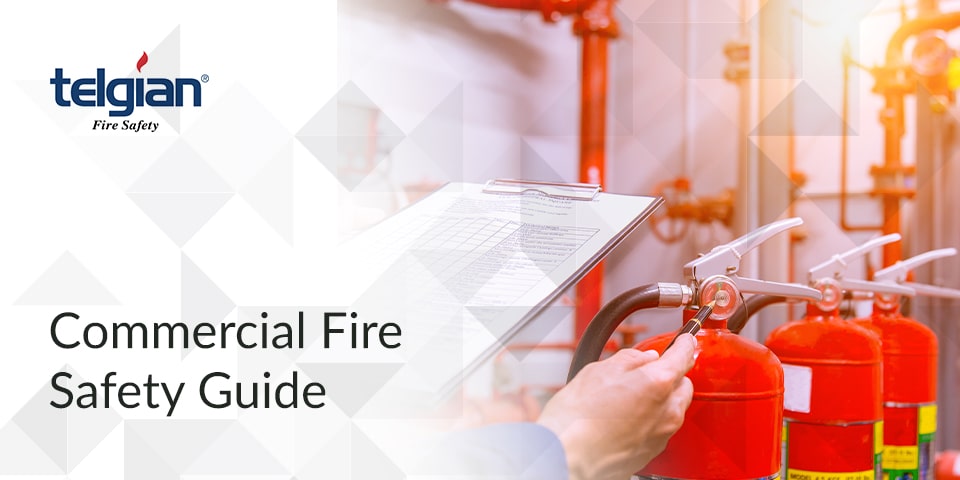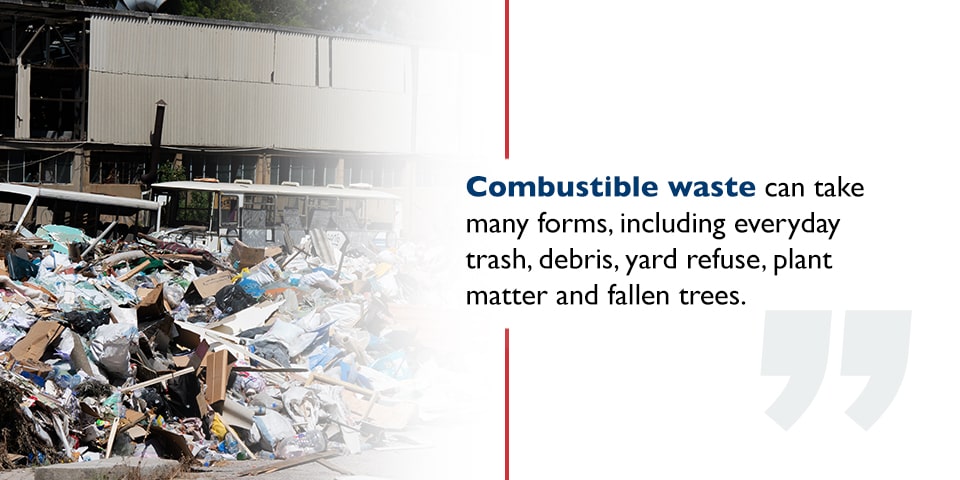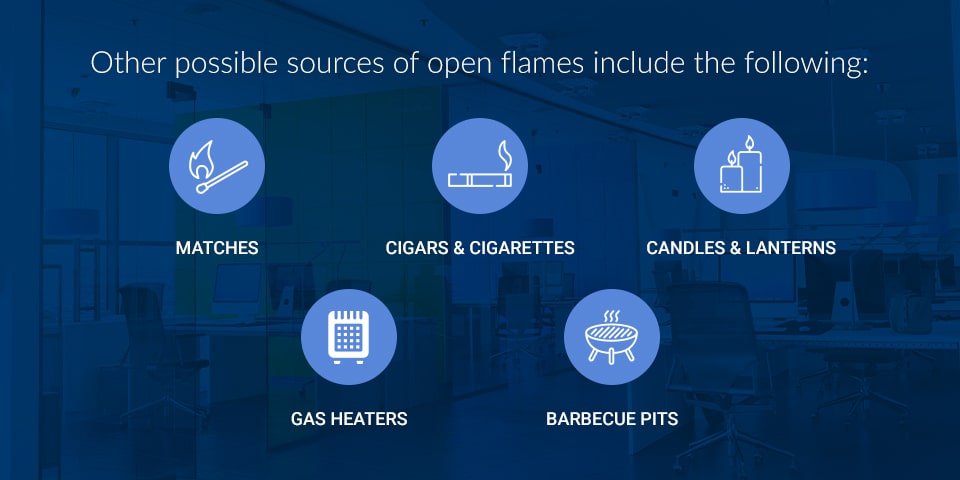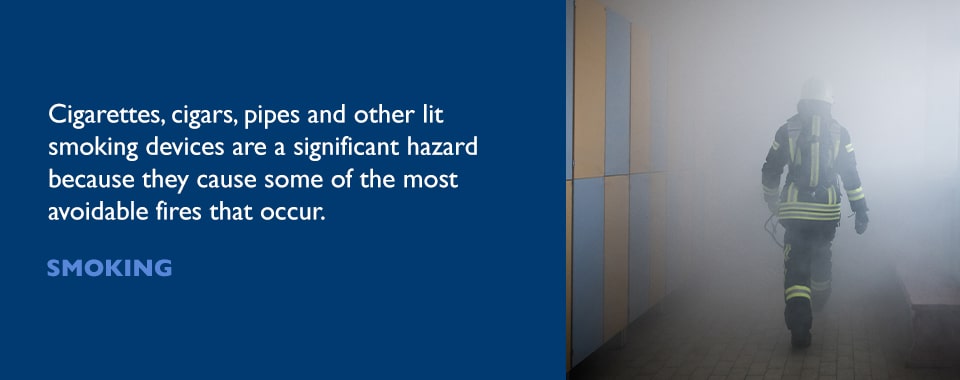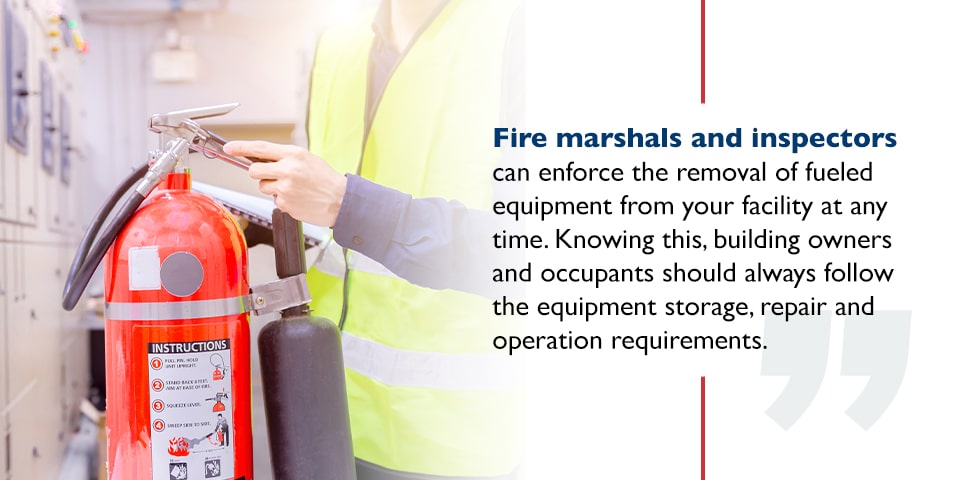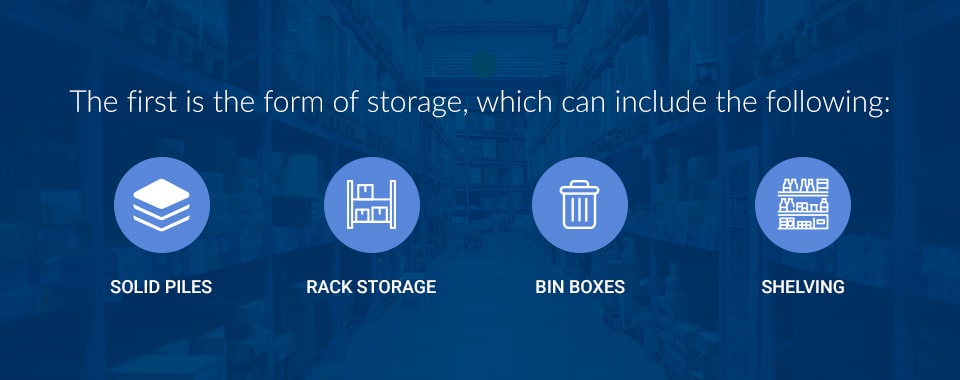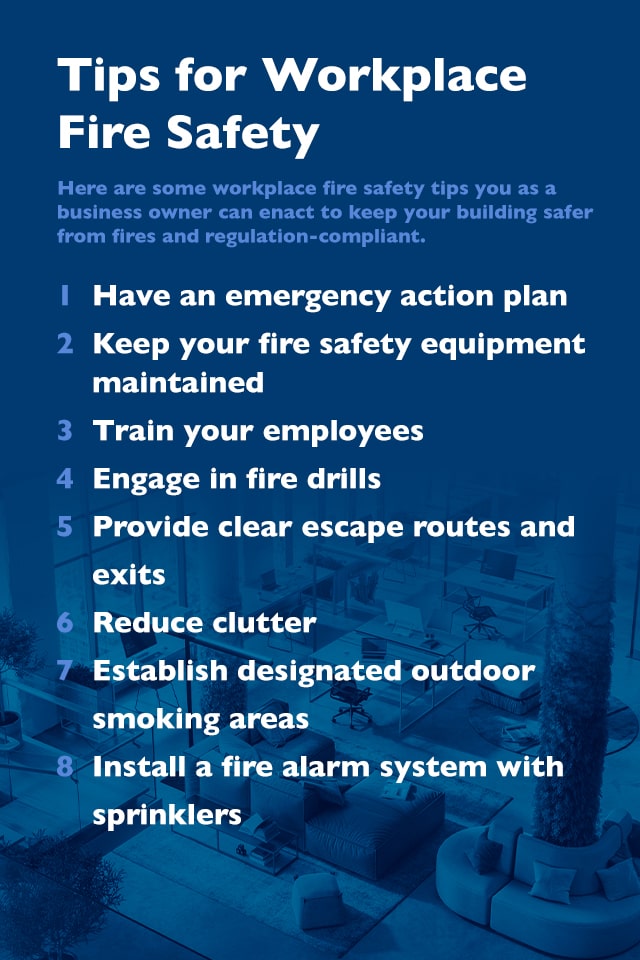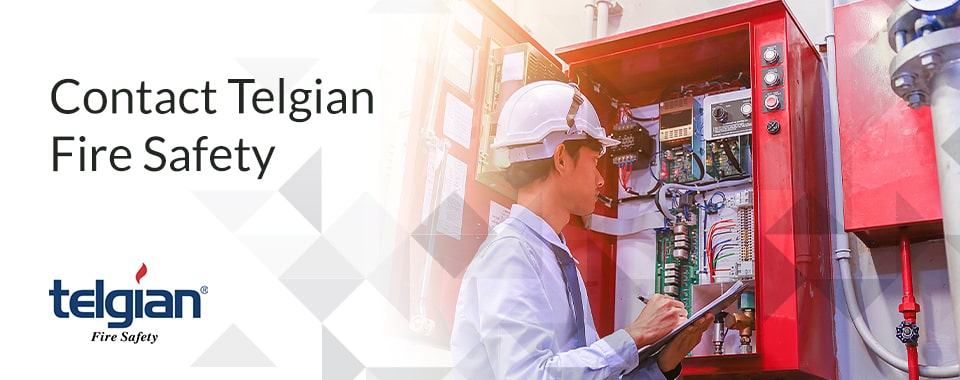Humankind has relied on fire for warmth, protection and sustenance throughout recorded history, but humanity’s relationship with fire has been tenuous. We continue to depend on fire for our survival, so it’s crucial to understand how mishandling it can result in unintended negative consequences.
Organizations such as the Occupational Safety and Health Administration and the National Fire Protection Association have created fire safety requirements for commercial facilities. NFPA codes and OSHA fire safety regulations provide the framework for you to achieve safety in your place of business. With the right fire safety guidance, you can better protect your employees and assets by reducing the risk of dangerous, damaging fire outbreaks at your property.
Understanding Fire
The first step in business fire safety is understanding fire. Fire consists of the following four elements:
-
- Fuel
- Oxygen
- Heat
- A chemical reaction between each of the previous three elements
Once all four elements combine, they result in the chemical reaction we call fire. If you remove any of these four elements from the equation, the fire will go out or be unable to start at all. When it comes to fire, it’s all four or nothing. You can use this knowledge to your advantage when seeking greater commercial fire safety.
For instance, fuel such as lumber or gasoline stored in a hot room won’t combust if you remove the heat source. Likewise, you can extinguish a fire by depriving it of oxygen. Knowing fire’s makeup can help you make logical decisions and adjustments throughout your facility to ensure safer conditions for everyone. Limiting the chance of the three elements of fire combining to combust is crucial.
Whose Responsibility Is Fire Safety?
Many people remember Smokey Bear’s famous saying, “Only you can prevent forest fires.” This statement captures every person’s duty to do their part to prevent outdoor fires. But this principle of personal responsibility also applies to commercial fire safety and preventing fires indoors. One person neglecting fire protection protocol is enough to risk everyone’s safety in your business building.
Every business facility can contain four types of people at any time. Each group carries different responsibilities regarding fire safety. Here are the three groups and their roles in preventing fires.
-
-
-
- Building owners: This group has a heightened responsibility to protect the people and contents in their buildings. Facility-wide fire safety starts with them. Installing fire protection and alarm systems is an excellent starting point. After that, it’s their role to keep these systems current and perform regular inspections to ensure they work during an emergency. They should also foster a fire safety culture within their company to raise awareness of the issue and proper practices.
- Building occupants: These are the people who use and populate a building every day. They’re responsible for maintaining the facility and keeping it in a condition that reduces its chances of fires. They ensure buildings follow OSHA fire safety standards and all applicable NFPA codes.
- Fire marshals and inspectors: These groups and individuals only spend a small amount of time in specific facilities. Their role is to make sure building owners and occupants are implementing and adhering to all necessary fire safety practices. They conduct inspections that function as a critical piece of a facility’s fire safety. They have the authority to inflict fines and sanctions if owners and occupants are not following fire safety practices.
- Fire protection companies: These businesses employ trained professionals who will check your facility for proper fire safety practices and regulation adherence. They offer services including inspections, maintenance and repair to keep your facility safer in the event of a fire.
-
-
Protecting Your Facility, Assets and Employees
As a business owner or property manager, you are responsible for protecting your building occupants, your assets and the facility itself. You must also make sure you’re staying regulation-compliant to satisfy inspectors and fire marshals. These can include indoor and outdoor scenarios, depending on your property.
Every business facility is unique. Businesses deal with different materials and conditions that can put them more or less at risk of fires. Some facilities may have an increased chance of electrical fires. Others may need to take more precautions against the combustion of lumber or paper. Understand the type of business you run and what steps you should take to keep everyone safe.
The next sections will take a closer look at aspects of business facilities related to the use of fire and the potential for the combustion of unwanted fires. It’s crucial that you understand these concepts, as OSHA and the NFPA have introduced many regulations around safe fire practices. You and your building occupants need to work together on each of these to achieve proper fire safety.
Combustible Waste
Combustible waste can take many forms, including everyday trash, debris, yard refuse, plant matter and fallen trees. Fire laws prohibit the accumulation of these items anywhere except intended disposal locations. Without proper treatment, combustible waste can pose a severe fire hazard to your business.
OSHA and the NFPA understand you cannot remove all the waste on your property at once and keep it that way at all times. For this reason, you should learn how to store your waste safely. Besides being a fire hazard, stored combustible waste can attract vermin and create other unsanitary conditions. Here are some of the ways you should store combustible waste.
-
-
-
- Keep storage containers away from the building.
- Storage containers near facilities should not contain oily rags or other unsafe materials without proper container identifications.
- You must use lids on containers 40 gallons or greater.
- Keep containers exceeding a capacity of 40.5 cubic feet outdoors and over five feet away from construction work.
-
-
Ignition Sources
Anything that can ignite combustible material is an ignition source, including heaters, lamps and other items that can produce flames or high heat levels. Building codes guide the placement of these items during construction, but some ignition sources need special attention even after the construction period.
These include business byproducts such as embers, hot ashes and smoldering coals. You must not deposit such items inside combustible waste receptacles, anywhere within 10 feet of flammable materials or within two feet of facility entrances and exits. You may find this self-evident, but reminders are always helpful in maintaining proper fire safety.
Open Flames
Many businesses rely on fire every day. Though open flames can be dangerous, the right conditions can minimize fire risk. Safe storage of combustible, explosive and flammable materials can reduce fire hazards in and around your property. You should keep such items as far from open flames as possible.
The definition of “open flames” extends beyond the obvious. A simple spark from an electrical appliance can also cause materials to combust. Make sure you follow safety protocol for electrical appliances near combustible materials. One easy way to obey regulations is to keep the right fire extinguisher nearby when dealing with open flames.
Other possible sources of open flames include the following:
-
-
-
- Matches
- Cigars and cigarettes
- Candles and lanterns
- Gas heaters
- Barbecue pits
- Signal markers
- Flaming food and drink preparations in restaurants
- Decorative devices
-
-
Powered Industrial Trucks
Forklifts, floor scrubbers and floor buffers are powered industrial equipment many businesses use regularly. These machines run on electric motors, batteries or combustion engines that rely on liquid or gaseous fuel. Types of fuel include standard gasoline, diesel or propane. You’ll need to abide by various standards when using and maintaining this powered industrial gear.
You must keep at least three feet of clearance around any battery charging stations, even if they are in an area away from regular foot traffic. And since batteries can leak, keep these areas well-ventilated to reduce the chance of flammable gas buildup. Have a fire extinguisher in these areas at all times.
Refuel your industrial trucks outside your business building. Indoor refueling stations need unique designs and approval to ensure the safe dispensing of fuel. Flammable vapors and spills pose a fire risk during refueling. Performing all refueling outdoors will reduce your facility’s fire risk.
Smoking
Most of today’s buildings are non-smoking establishments. Some businesses even regulate how close to their facility someone can smoke, with hospitals being an excellent example of this type of strict smoking protocol. Cigarettes, cigars, pipes and other lit smoking devices are a significant hazard because they cause some of the most avoidable fires that occur. Even electronic smoking devices like vapes pose a fire threat due to battery malfunctions. Plus, their vapor can trigger smoke alarms, causing an unnecessary facility evacuation.
Smoking near combustible materials and gases could be life-threatening, so enforce no-smoking laws in your business. Install no-smoking signs throughout your property. The fire code requires strict adherence to such signage, but it is up to you and your building occupants to ensure everyone follows these ordinances.
You must provide ashtrays in designated smoking areas to allow smokers to safely dispose of ash, used matches and burning tobacco products. This accommodation will help you avoid improper, hazardous discarding of smoking material.
Fueled Equipment
Here are some of the most common types of fueled equipment for businesses:
-
-
-
- Lawn and landscaping equipment
- Portable generators
- Mopeds
- Portable cooking gear
- Gas-powered tools and construction items
-
-
You must keep these items outside your building at all times, including when storing, operating or repairing them. Exceptions to this rule include purpose-built structures that have approved storage locations with functional sprinkler systems and a total fuel capacity within 10 gallons.
Fire marshals and inspectors can enforce the removal of fueled equipment from your facility at any time. Knowing this, building owners and occupants should always follow the equipment storage, repair and operation requirements.
General Storage
This topic could fill an entire fire safety manual on its own because of its complexity from business to business. Two factors play into general storage mandates. The first is the form of storage, which can include the following:
-
-
-
- Solid piles
- Rack storage
- Bin boxes
- Shelving
- Pallets
- Encapsulation
- Open grating
-
-
The second factor to consider is the stored items themselves. They can pose extreme risks to the facility if stored incorrectly. Items that pose a risk to your facility’s fire safety include plastics, aerosols and combustible and flammable liquids.
Here are some essential fire safety mandates from the International Code Council for general storage in your business facility:
-
-
-
- Stacks should be orderly and stable to prevent collapse, keep people from harm and allow movement throughout the facility for firefighters.
- Separate combustible materials from heaters and heating devices with a shield or by using adequate distancing.
- Provide sufficient clearance between the highest stored items and the ceiling in every situation. Leave a clearance of at least 36 inches for buildings with sprinkler systems and two feet for buildings without. This gap will allow water from the sprinkler systems and hose streams to reach the top of storage during fires.
- Keep exit paths, exit doors and exit discharges free from storage materials of any kind. Failing to do so could result in impeded access to exits during emergencies and fires blocking exits.
- Do not store combustible materials in electrical rooms, mechanical rooms or boiler rooms. These rooms contain ignition sources, and keeping materials there increases your facility’s fire risk.
- According to the fire code, you must maintain at least a 10-foot separation of outdoor storage from lot lines. Your facility’s authority-having jurisdiction may have different standards for storage of smaller height. This mandate allows firefighters to access all sides of outdoor storage.
- Storing items beneath canopies, eaves and other building outcroppings is against the fire code unless a sprinkler system is present.
- Keep solid piles 20 feet high or less to control the size of fires and reduce the chance of the piles tipping over. It also allows firefighters to reach the top of the piles with their hoses.
-
-
Hazards to Firefighters
Fighting fires is one of the world’s most dangerous professions. But the dangers a firefighter faces aren’t always from the fires themselves. Some indoor areas can pose risks to every firefighter as they enter to save your assets and assist any occupants having difficulty exiting.
Your duty as a business owner or operator is to decrease risks for the people who put their lives on the line when they enter flaming buildings. Shut all trapdoors and unguarded openings in the floor. Identify any vertical shafts to keep firefighters from falling through. This advice is especially crucial when entering a facility from a ladder placed against the building’s exterior.
You must also keep obstructions, including wires, ropes and cables, clear from roofs. These can be tripping hazards to firefighters maneuvering atop your building’s roof. Any of these items above your roof must maintain a height of at least seven feet to allow firefighters to pass beneath them. This rule applies to all roofs with slopes less than 30 degrees.
Tips for Workplace Fire Safety
Everyone must do their part for successful fire safety. From building owners and occupants to the fire marshals conducting inspections, everyone has a role in protecting places of business around the country. The NFPA codes and standards and OSHA fire safety regulations outline many proper practices. Here are some workplace fire safety tips you as a business owner can enact to keep your facility safer from fires and regulation-compliant.
-
-
-
- Have an emergency action plan: OSHA requires businesses to create an EAP to let everyone know what to do during a fire. Post this in a public location, so it is visible to all employees. The EAP should outline what everyone should do if a fire breaks out, including following a safe evacuation route to a designated meeting location.
- Keep your fire safety equipment maintained: Many fire regulations demand the presence of fire extinguishers and other fire safety equipment throughout the facility. You must also ensure these essential pieces of gear stay functional in case an emergency ever arises. Keep your extinguishers and other gear regulation-compliant with routine inspections and scheduled maintenance.
- Train your employees: Thorough training for your employees and all building occupants will go a long way in protecting them and your entire facility from potential fires. Assign team members specific duties, including a designated “fire officer” to take charge in the face of an emergency. They can also create escape plans and meeting locations to ensure calm, orderly evacuations if a fire ever strikes.
- Engage in fire drills: Once you have an EAP in place for emergencies, you and your team need to rehearse it. Participating in business-wide fire drills will give everyone confidence that they’ll know what to do during a fire. If a fire breaks out, it will also make the situation less stressful for everyone. Since they’ve all practiced together, they should stay calm and carry out the plan.
- Provide clear escape routes and exits: As you learned throughout this guide, escape routes and exit doors are crucial for fire safety. You should always leave them clear of obstructions. But it’s also essential to keep them visible, so building occupants know where they are at all times. Invest in high-quality emergency exit lights to ensure people can find an exit when they need one most.
- Reduce clutter: Clutter is a leading contributor to fires and fire risks. Piles of combustible material do more than lead to large structure fires. They can block exits and make it difficult for firefighters to do their job. Instruct building occupants to put waste in the proper waste disposal locations and to always keep walkways and doors clear from obstructions.
- Establish designated outdoor smoking areas: Unsafe smoking practices are another leading cause of fires in businesses. Enforce a smoke-free policy throughout your facility and create designated smoking areas equipped with ashtrays for anyone who wishes to engage in the activity. If your business deals with combustible materials, fuels and gases, this tip is essential in avoiding fires caused by careless smoking accidents.
- Install a fire alarm system with sprinklers: This recommendation may be last on this list, but it’s one of the most essential for fire protection and safety. A fire alarm system is the first step in alerting building occupants to smoke, carbon monoxide and other signs of fire. Take your system to the next level with fire sprinklers to stop fires from spreading and protect your facility, your assets and the people within.
-
-
Contact Telgian to Learn About Our Fire and Life Safety Services
Telgian is your leading source for fire safety information and implementation. Since 1985, we’ve emphasized innovative solutions for businesses looking to take their next fire safety steps. We maintain a close relationship with the NFPA and other professional safety organizations to stay on the cutting edge of fire safety technology and regulatory compliance.
We can use our knowledge and relationships to inspect, test and repair your business’ fire safety equipment. We can even provide services for companies with several locations. No project is too big or small. We’re your partner in achieving your goal of creating a safe business environment.
Let us keep your property and its occupants safe from fires. In the meantime, we can help you pass inspections with our fire safety gear and expertise. Contact us today for more information on how to prepare for fires with Telgian. We look forward to serving you.
